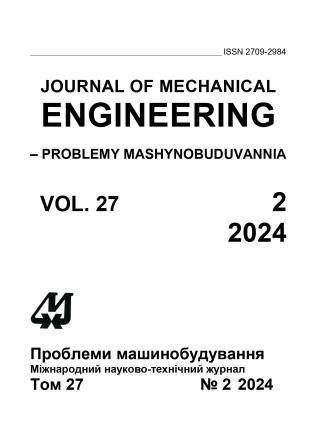Numerical Analysis of the Stress State of Near-Circular Hollow Cylinders Made of Functionally Graded Materials
Abstract
Hollow cylinders of circular cross-section, made of functionally graded materials, are used in many branches of economy as structural elements and parts of machines and units. During manufacturing or in the process of operation of such cylinders, the shape of their cross-sections may differ from the circular one to some extent. A solution of the equilibrium problem of hollow cylinders of non-uniform thickness, which are close to circular ones, in a 3D formulation under certain boundary conditions at the ends is considered in this paper. The cross-sections of the considered cylinders are described using Pascal's limacon equation. A two-component continuously non-homogeneous material, which elastic properties, characterizing Young's modulus and Poisson's ratio, can be determined using concentration of the composition materials along the thickness, was chosen as the cylinder material. The aim of the paper is numerical analysis of the stress state of cylinders of such class depending on the law of variation of elastic properties of their material. The solution of the problem is based on reduction of the original three-dimensional boundary value problem for the system of partial differential equations with variable coefficients to a one-dimensional boundary value problem for a system of ordinary differential equations with constant coefficients of higher order. At the same time, the analytical method of separating variables in two coordinate directions with approximation of functions by discrete Fourier series is used. The one-dimensional boundary value problem is solved by the stable numerical method of discrete orthogonalization. The analysis of the stress state of cylinders depending on the dent size that appear in the neighborhood of the reference surface diameter and the law of variation of the material elastic properties was performed. It is shown that the nonlinearity of the law of the elastic properties distribution along the thickness leads to an increase/decrease of maximum values of normal displacements and longitudinal stresses by 1.3 times compared to the linear law. At the same time, an increase in the dent size leads to an increase of both the displacements and normal stresses by 2-3 times in the zone of the dent maximum dimension compared to the diametrically opposite zone. The results obtained in the paper can be used in strength calculations of structural elements and parts of machines of a similar type.
Downloads
Published
Issue
Section
License
Copyright (c) 2024 Л. С. Рожок

This work is licensed under a Creative Commons Attribution-NoDerivatives 4.0 International License.
All authors agree with the following conditions:
- The authors reserve the right to claim authorship of their work and transfer to the journal the right of first publication of the work under the license agreement (the agreement).
- Authors have a right to conclude independently additional agreement on non-exclusive spreading the work in the form in which it was published by the jpurnal (for example, to place the work in institution repository or to publish as a part of a monograph), providing a link to the first publication of the work in this journal.
- Journal policy allows authors to place the manuscript in the Internet (for example, in the institution repository or on a personal web sites) both before its submission to the editorial board and during its editorial processing, as this ensures the productive scientific discussion and impact positively on the efficiency and dynamics of citation of published work (see The Effect of Open Access).

